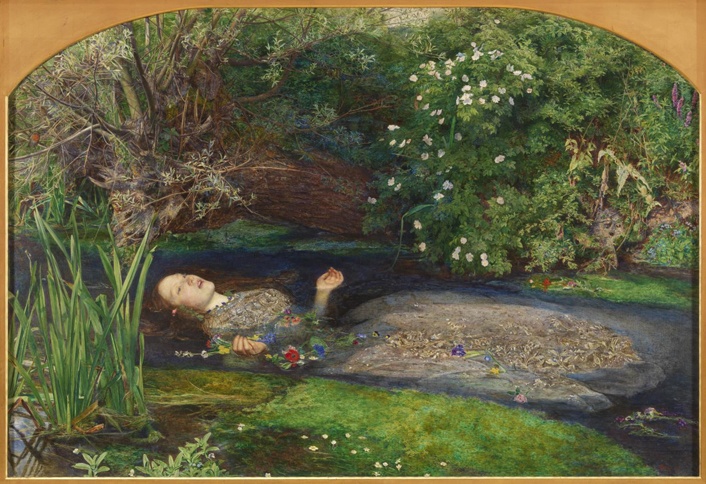Based on the character from Shakespeare’s Hamlet, Ophelia (1851–52) by Sir John Everett Millais (1829–96) exemplifies many of the values upheld by the Pre-Raphaelite Brotherhood. Millais, along with Dante Gabriel Rossetti and William Holman Hunt, formed the group in 1848 and propounded artistic principles that took their influence from the ideas of John Ruskin. The Pre-Raphaelites favoured vivid colour and detail, with a focus on and accurate depiction of nature. This piece, in all its haunting serenity, depicts the moments surrounding Ophelia’s death. The plants, among which Ophelia is shown held afloat, are loaded with symbolism and refer directly to the lines uttered by Queen Gertrude in the play. The Queen announces the news to Ophelia’s brother through an immensely poetic speech (Act 4 Scene vii), which effectively transforms Ophelia’s death into a scene of ethereal beauty. So vivid is the description that it seems already to describe a painting of the tragic event, and it has as such served as inspiration for several artworks, not just by Millais but also by John William Waterhouse, Arthur Hughes and Alexandre Cabanel.
‘Truth to Nature’
It was intended by Ruskin that the smallest detail should enjoy its own identity just as each person had his or her own. It was not enough to show the species, each plant had to have its own individual identity, a statement of God’s manifest Creation in all its diversity and wonder. According to Ruskin, writing in his pamphlet Pre-Raphaelitism (published in 1851), ‘[Artists] should go to nature in all singleness of heart … rejecting nothing, selecting nothing and scorning nothing’. Such was the importance of the natural elements in this painting that the figure of Ophelia was added only after the background had been completed.
 The Part of Ophelia
The Part of Ophelia
The model for this scene was Elizabeth Siddal (who later married Dante Gabriel Rossetti). Siddal posed for the painting across a four-month period by lying in a bath, from which she caught a chill. Her role as Ophelia for this painting was somewhat prophetic in that Siddal – whose grief for her stillborn daughter and husband’s infidelities exacerbated a long period of illness, precarious mental health and laudanum addiction – died of an overdose in 1862.
Key Information
Medium: Oil on canvas
Dimensions: 76.2 x 111.8 cm (30 x 44 in)
Location: Tate Britain, London
Get ready for the new year already with our new Tate Millais 2017 calendar, which showcases some of Millais’ finest works, including the hugely popular Ophelia. Or, if you’d like to find out more about the Pre-Raphaelites and the range of work produced by this circle of artists, you need look no further than our book Pre-Raphaelites: Masterpieces of Art, which you can buy here.
Top Image: Ophelia, Sir John Everett Millais, image courtesy of Tate Gallery
Bottom Image: Self-portrait, Elizabeth Siddal
Check out all of the Top 10 Paintings blog posts!
- Top 10 Paintings | 1 | The Kiss by Gustav Klimt
- Top 10 Paintings | 2 | Composition VII by Wassily Kandinsky
- Top 10 Paintings | 3 | In the Well of the Great Wave of Kanagawa by Katsushika Hokusai
- Top 10 Paintings | 4 | Starry Night Over the Rhône by Vincent Van Gogh
- Top 10 Paintings | 5 | The Scream by Edvard Munch
- Top 10 Paintings | 6 | Fighting Temeraire by J.M.W. Turner
- Top 10 Paintings | 7 | The Persistence of Memory by Salvador Dali
- Top 10 Paintings | 8 | Nighthawks by Edward Hopper
- Top 10 Paintings | 9 | Water Lillies by Claude Monet
- Top 10 Paintings | 10 | Ophelia by Sir John Everett Millais




